BY STEVE JOHNSON ()
Power supplies are commonplace on today's service and engineering benches and are one of the most commonly used pieces of equipment on home hobbyist and experimenter's workbenches.
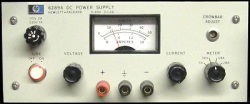
A vintage Hewlett-Packard bench dc power supply.
Actually one of the first common ac-powered electrical devices purchased for the home by consumers after Edison's electric light bulb was a power supply that could supply the dc voltages needed to replace batteries in a home radio. These power supplies were called “Battery Eliminators.” Early radios of the 1920s needed several batteries as radio had become popular before most houses had been wired for electricity. Frequently recharging or replacing radio batteries was expensive and trips to the local radio shop were time consuming. Battery eliminators solved this problem.
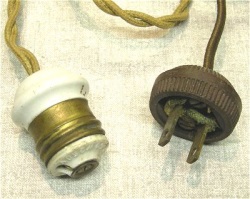
A 1920s Edison ac plug (left) and 1930s bladed plug (right).
The earliest battery eliminators appeared in the mid 1920s and were wired usually with an Edison-style screw-in plug similar to that found on light bulbs. Since early house wiring was intended for electric lighting, standard two prong wall outlets for ac-powered appliances had not appeared yet. By 1929, most battery eliminators were supplied with a standard two prong plug similar to what we still use today. By the early 1930s, newer radios that ran on household ac made the need for these early power supplies obsolete.
Bench power supplies have been in widespread use by engineers since the early days of electronics and the availability of ac power. Today, both ac and dc power supplies are used by engineers and electronic hobbyists when prototyping circuits and restoring vintage equipment.
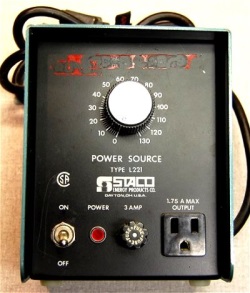
A typical surplus “variac” ac power supply.
One of the recommended procedures for restoring vintage electronic equipment that has not been powered on in many years is to bring the ac supply voltage up slowly. This helps to reform capacitors that may have dried out or developed leakage from sitting unused for many years. It also allows the current draw to be monitored during a slow power up and hopefully cut the supply voltage quickly before any components or the transformer is damaged if a spike in current appears. Just plugging an old amplifier or radio in and turning it on after it has set unused for many years has often ruined what would have been an easily restorable piece of electronics.
AC power supplies designed to bring up the power slowly are called variacs. Some are just an autotransformer with a large knob marked in a percentage of output (0 to 100%) or actual ac voltage output (0 to 140 Vac). Others are enclosed in a cabinet with voltage and current meters to monitor the voltage and current output along with a fuse or circuit breaker to protect the windings from over current. A variac with a current output of 2.5 to 5 A (300 to 600 VA) should be sufficient to power most vintage home audio and radio equipment.
Variacs range in price from $20 to $30 for a basic used 1 to 2-A knob-only model to $125 to $200 for a metered version with a 5 to 10-A output. If you are patient, you may be able to find one at a swap meet for half that.
Probably the most common piece of equipment on most electronics benches today after a meter and soldering iron is a direct current power supply. DC supplies are used to power everything from prototype circuits under development to car radios on a service bench.
Some great buys are out there in vintage dc power supplies. Surplus dc power supplies costing hundreds if not thousands of dollars originally may now be found for $50 to $250 in good working condition. When searching for a power supply it's important to know what the voltage and current requirements of your projects will be. If someone works on many different types of projects a dc power supply with a higher ± voltage range and current output may be required and a power supply with a current limit feature is recommended. Current limiting may not only protect components in your circuit but will also protect your power supply from trying to supply more current than it was designed for.
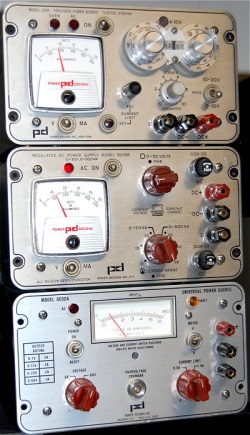
The popular Power Designs dc supply series.
Although I have Hewlett-Packard, Tektronix, and Heath dc supplies on my bench, my personal favorites are a series of Power Designs variable dc power supplies I've acquired over the years. Power Designs Inc. was located in Westbury, NY, and Palo Alto, CA. They designed and manufactured a series of bench supplies in the 1960s that are still popular with hobbyists today.
Model numbers were based on the maximum voltage and current output of a particular model. The first two digits signified the maximum voltage and the second two digits the maximum current output. A model 2005 was a 20-V, 0.5-A dc supply. A 6050 was a 60-V, 5-A dc supply. A letter at the end of the model number signified the style and features of the supply.
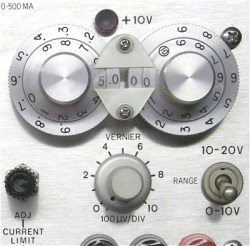
The Power Designs model 2005's unique voltage control knobs.
My favorite is the Power Designs model 2005 “Precision Power Source.” The voltage is set by a combination of four knobs with detents and a times 10 switch. You could set the four knobs to your required voltage within a hundredth of a volt and read it in the center window between the knobs. It is unnecessary to adjust the voltage by reading a meter, but one is included on the face of the meter that displays voltage and current output. Although other power supplies in this series have current-limiting controls, the model 2005 incorporates a set button to allow the current-limit setting to be viewed directly on the meter even if the supply is out of the circuit.
Prices on this series of dc supplies vary, and it pays to be patient when shopping for a used power supply. I have seen both Hewlett-Packard and Power Designs supplies sell online for $80 to $150 in good working condition and at swap meets for as little as $50. The higher-voltage and -current supplies in the Power Designs series might sell for slightly higher, but a 0.5-A model will supply ±dc voltages for many smaller analog and digital prototype circuits.
For more information and examples of early electronic technology, view my collection at StevesAntiqueTechnology.com.
Related Products: Power Supplies
Advertisement
Learn more about Electronic Products Magazine





